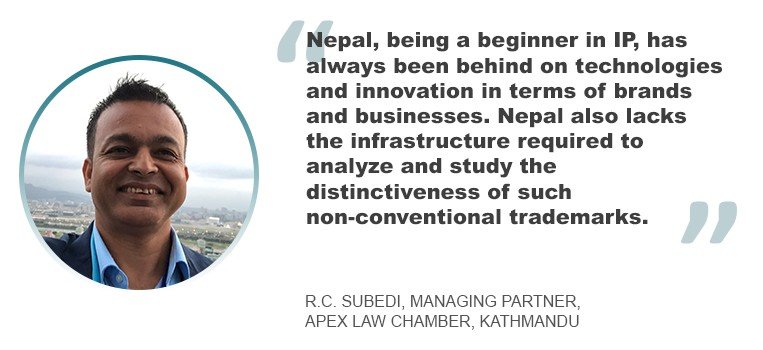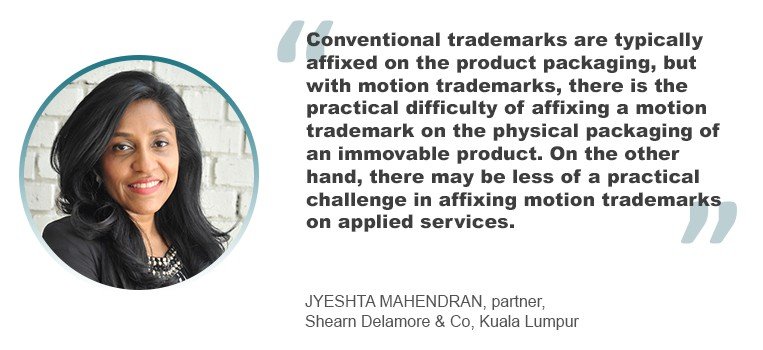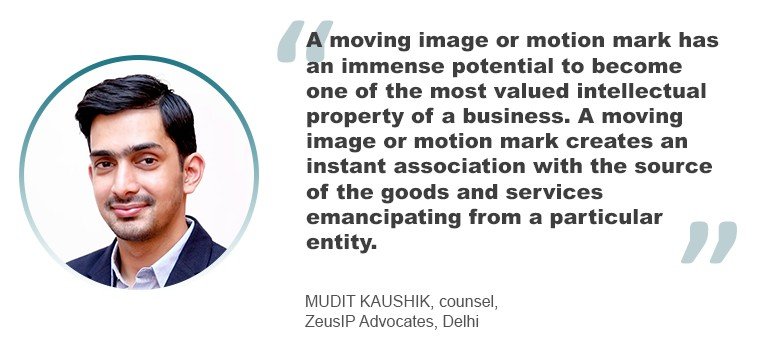Moving images: A new wave of advertisement
31 July 2021
 As brand owners become increasingly creative with their use of moving images in their logos, lawyers around the region have devised a variety of ways to protect those moving images. Excel V. Dyquiangco reports.
As brand owners become increasingly creative with their use of moving images in their logos, lawyers around the region have devised a variety of ways to protect those moving images. Excel V. Dyquiangco reports.
The use of moving images in logos and brands these days has brought advertising to a whole new direction, especially in light of the pandemic. Also known as a “motion trademark,” which is already common especially for technology-based products such as mobile phones and computer programs, a strong moving image is useful to strengthen the product branding since it is visually remarkable.
In fact, companies such as Apple and Coca-Cola are slowly veering away from the stoic and instead embracing a new platform that is gradually revolutionizing the industry, attracting fresh clients and customers in the process. Aside from these companies, some of the more popular trademarked moving images in the Asia-Pacific are an animated logo sequence owned by Microsoft, Toyota’s jump trademark (which dates to the 1980s) and the Sony mobile logo, among others.
But with this newfound technology, are the region’s IP laws prepared to face a Herculean task in protecting the rights of moving images? And, at a perhaps more basic level, can you trademark a moving image?
Well, it all depends on where you are. A moving image can be registered as a trademark in several Asia-Pacific countries, including Japan, South Korea, Singapore, Malaysia and Australia, but is not recognized in other countries, such as Indonesia and Nepal.

“The Indonesian trademark law, which came into effect since November 26, 2016, only provides protection for a sound mark, three-dimensional trademark, hologram mark, wordmark, two-dimensional mark or combination of two or more of those elements,” says Fortuna Alvariza, managing partner at FAIP Advocates & IP Counsels in Jakarta. “But in my opinion, protection of the moving image is a good step in solving the problem of the conventional nature of the trademark which only protects words, images, logos or a combination thereof. We can see that moving images are becoming an increasingly powerful aspect of digital marketing in this era. I hope that trademark law in the Asia-Pacific countries, particularly in Indonesia, is evolving to recognize and protect innovative approaches to trademark.”
She adds, “As the moving image is still not recognized under the Indonesian trademark law, I suggest that it can be alternatively protected as a copyright under the Indonesian copyright law. The moving image can be categorized as a visual audio under the copyright law.”
While Nepal has had a Patent Design and Trademark Act since 1936 – probably the oldest IP act in the South Asian Association for Regional Cooperation (SAARC) region, even though Nepal is still somewhat known as a being in the beginning steps of IP protection – registration of moving images as trademarks has not come into existence yet.
“As we know, laws are modified along with the development of technologies which leads to the need of regulation and protection to people with regard to such developments,” says R.C. Subedi, managing partner at Apex Law Chamber in Kathmandu. “In my case, no client has requested for registration of such moving images. I believe that one of the reasons could be lack of innovation from the part of major brands as well as businesses. Nepal, being a beginner in IP, has always been behind on technologies and innovation in terms of brands and businesses. Nepal also lacks the infrastructure required to analyze and study the distinctiveness of such non-conventional trademarks.”

He adds: “However, talking about whether or not our country Nepal is equipped with IP laws to handle such a trademark registration, as per the definition of trademark in our Patent, Design and Trademark Act, 1965 ‘trademark’ means word, symbol or picture or a combination thereof to be used by any firm, company or individual in its products or services to distinguish them with the product or services of others. So, this combination of pictures can be brought into interpretation of moving image or motion image. Also, seeing the practice in other countries like the United States and Canada, application for registration of moving images shall include freezing the images/pictures in different frames or including animation clips and it shall also include a clear and concise description of the whole visual effect of the animation from start to end.”
“Adopting the practices in developed countries could also help our country to bring such development and changes in the registration of non-traditional trademarks,” he says. “Thus, regarding these non-traditional trademarks, Nepal seems to be little behind in practice.”
Creativity and innovation in a moving image
Although Indonesia has not had a specific law in protecting a moving image, Alvariza says that a moving image must be able to visually show obvious distinctiveness. “Ideally, it must be unique as it is used as the identity and characteristic of the brand in endeavour to gain society's knowledge,” she says. “Given this, trademark owners must be extra creative and innovative to be able to create a moving image which can fulfill the aforesaid expected function.”

She adds: “Apart from that, I believe that the examination process of a moving image trademark application is more challenging compared to the other type of trademarks. A moving image trademark usually consists of animation, logo, words, characters, colours, music or sound, or combination of the said elements. Therefore, there are more aspects that must be examined before a motion is approved to be protected.”
Jyeshta Mahendran, a partner at Shearn Delamore & Co in Kuala Lumpur, agrees, saying that representing a depiction of a motion trademark can be seen as one of the practical challenges in the registration of motion trademarks.
“For instance, conventional trademarks are typically affixed on the product packaging but with motion trademarks, there is the practical difficulty of affixing a motion trademark on the physical packaging of an immovable product,” she says. “On the other hand, there may be less of a practical challenge in affixing motion trademarks on applied services. Uniformity in the requirement for submission of applications for motion trademarks at the various intellectual property offices around the world is also desirable to ensure consistency in the protection and enforcement of such rights worldwide.”
Aside from such practical challenges, satisfying registrability requirements is also forthcoming when it comes to showing that the motion trademark fulfils the distinctive requirements under the Trademarks Act 2019 in Malaysia.

“The examination of motion trademarks is only at its infancy stage in Malaysia due to the recent recognition of non-traditional trademarks in the Malaysian IP legislation,” says her colleague, Elisia Engku Kangon, an associate at Shearn Delamore & Co. “At the time of writing, only two new motion trademarks have been filed [and are] pending examination since the introduction of non-traditional trademarks. As such, there is no clear guidance or precedents on the treatment and validity of motion trademarks in Malaysia. Given the novelty of registering motion trademarks in Malaysia, we would have to adopt a wait-and-see approach as to how the Malaysian Registry will approach the examination of motion trademarks. Such examination will follow the usual course of examination as provisions for expedited examination of trademark applications (which is available under certain circumstances) is not available for applications involving non-traditional trademarks including a sequence of motion.”
Impacting consumers and businesses
While the pandemic has forced businesses to promote their goods/services digitally as the traditional modes of promotion remain unavailable or hampered due to the challenging circumstances, this has unknowingly given birth to moving images/motion marks.
“A moving image or motion mark has an immense potential to become one of the most valued intellectual property of a business,” says Mudit Kaushik, counsel at ZeusIP Advocates in Delhi. “As a moving image or motion mark creates an instant association with the source of the goods and services emancipating from a particular entity, securing statutory rights in the same will only assist an entity in commercially appropriating the same. It is not a hidden secret that a formal registration of a trademark [including a moving image or motion mark] adds great value while enforcing rights against third-party infringers.”
He adds: “Moving images and motion marks are indeed considered as attention grabbers and there is nothing that businesses would like more than capturing the attention of the potential customers while keeping the existing ones engaged. Adopting a moving image or motion mark by a business is considered a great marketing strategy coupled with the advantage to distinguish its goods and services from the other manufacturers and service providers in the trade. Accordingly, a moving image or motion mark acts as a fantastic source identifier, using which the businesses get a chance to stand out from the competitors while innovatively connecting with the customers at the same time.”

Subedi says that trademarking moving images, according to its scope, protects the creativity or goodwill one brand has put into for its marketing or branding strategy.“Trade marking of moving images has widened the perspective of branding of the businesses,”he says. “It surely helps distinguish any brand from other brands in a new way. So,trademarking of such a moving image is necessary to protect it from being infringed. Trademarking moving images will also help them in a new style of advertising by consuming less screen time which may cost them less as well.”
He adds:“In terms of consumers, trademarking moving images will help consumers distinguish abrand in a marketplace. And this way, consumers are also engaged with fresh product branding.”“As mentioned, trademarks offer additional layers of protection and exclusivity, which is a useful tool in a company’s intellectual property strategy,” says Mahendran. “The inherent nature of the human mind and senses in differentiating different forms of sounds, smell and images is an added incentive in the development and protection of non-traditional trademarks as an additional formof branding. Consumers would naturally be drawn to moving images as compared to still images which can be more effective in distinguishing the goods and services of one proprietor from that of another. To that end, it is also imperative to ensure that the expansion of non-traditional trademarks beyond a word or logo will not create an undue monopoly to a certain smell, colour, motion or taste.”
Adds Kangon:“There is no denying that the backing of a strong trademark can easily transitionthe sale of that same product from a brick and mortar to an online platform. Adding a motion image to a company’s portfolio of trademarks would certainly be another means of standing out from a competitors.”






